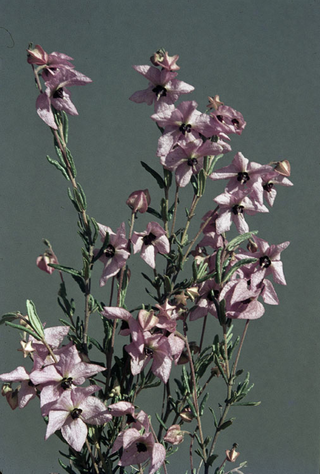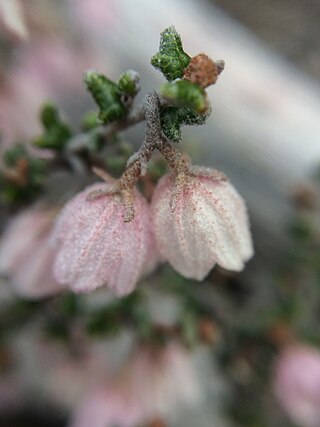
Guichenotia ledifolia is a species of flowering plant in the family Malvaceae and is endemic to the southwest of Western Australia. It is a densely-branched shrub with densely hairy new growth, hairy, linear to oblong leaves and pink to mauve flowers arranged in groups of three to ten.

Guichenotia macrantha, commonly known as large-flowered guichenotia, is a species of flowering plant in the family Malvaceae. It is a shrub with grey-green leaves, mauve flowers and is endemic to Western Australia.

Commersonia craurophylla, commonly known as brittle leaved rulingia, is a species of flowering plant in the family Malvaceae and endemic to southern continental Australia. It is a dense, spreading shrub with crinkled, narrowly oblong to linear leaves, and white to cream-coloured flowers.

Conostephium minus, common name pink-tipped pearl flower, is a species of flowering plant in the family Ericaceae and is endemic to the southwest of Western Australia. It is an erect shrub with linear leaves and white and purplish-pink flowers.
Lasiopetalum lineare is a species of flowering plant in the family Malvaceae and is endemic to the south-west of Western Australia. It is an erect shrub with densely hairy young stems, linear leaves and bright pink and dark red flowers.

Lasiopetalum oppositifolium is a species of flowering plant in the family Malvaceae and is endemic to the south-west of Western Australia. It is an open, erect shrub with rusty-hairy young stems, linear, narrowly elliptic or narrowly egg-shaped leaves and white, pink and dark red flowers.

Thomasia discolor is a species of flowering plant in the family Malvaceae and is endemic to the south-west of Western Australia. It is a multi-stemmed shrub with densely hairy branchlets, coarsely serrated, egg-shaped leaves with a heart-shaped base, and many small pink, cream-coloured or white flowers.

Guichenotia sarotes is a species of flowering plant in the family Malvaceae and is endemic to the southwest of Western Australia. It is a spindly, low-growing shrub with densely hairy new growth, hairy, greyish, linear leaves and pink to purple flowers arranged in loose groups of two to six.
Thomasia rulingioides is a species of flowering plant in the family Malvaceae and is endemic to the south-west of Western Australia. It is an erect, open shrub with densely hairy new growth, narrowly oblong to narrowly egg-shaped leaves with wavy edges, and pink to purple flowers.
Guichenotia alba is a flowering plant in the family Malvaceae and is endemic to Western Australia. It is a slender, spreading shrub with lax, hairy young branches, leaves with the edges rolled under, and white flowers.

Guichenotia angustifolia is a species of flowering plant in the family Malvaceae and is endemic to the south-west of Western Australia. It is an erect, prostrate or climbing shrub with hairy young growth, hairy, oblong to linear leaves and pink to mauve flowers.

Guichenotia apetala is a flowering plant in the family Malvaceae and is endemic to a small area in the southwest of Western Australia. It is a small, erect, compact shrub with many branches, densely hairy new growth, triangular to heart-shaped leaves, and salmon pink flowers.
Guichenotia astropletha is a flowering plant in the family Malvaceae and is endemic to the southwest of Western Australia. It is a dwarf, spreading shrub with hairy new growth, linear to narrowly egg-shaped leaves, and pink flowers.
Guichenotia glandulosa is a species of flowering plant in the family Malvaceae and is endemic to a small area in the south-west of Western Australia. It is a spreading, dwarf shrub with hairy new growth, more or less linear leaves with the edges turned down, and pink flowers arranged in groups of six or seven.
Guichenotia impudica is a species of flowering plant in the family Malvaceae and is endemic to the south-west of Western Australia. It is a spreading, dwarf shrub with hairy new growth, more or less linear leaves with the edges turned down, and pink flowers arranged in groups of six or seven.

Guichenotia micrantha, commonly known as small flowered guichenotia, is a species of flowering plant in the family Malvaceae and is endemic to the south-west of Western Australia. It is a low, compact shrub with linear to narrowly egg-shaped leaves and pink flowers in groups of three to six.
Guichenotia quasicalva is a species of flowering plant in the family Malvaceae and is endemic to the south-west of Western Australia. It is a low, spindly shrub with narrowly egg-shaped to linear leaves and pink flowers in groups of two to four.
Guichenotia seorsiflora is a species of flowering plant in the family Malvaceae and is endemic to the south-west of Western Australia. It is a low, spreading, multi-stemmed shrub with linear to narrowly egg-shaped leaves and white flowers arranged singly in upper leaf axils.
Guichenotia tuberculata is a species of flowering plant in the family Malvaceae and is endemic to the south-west of Western Australia. It is a low, spreading shrub with linear to narrowly egg-shaped leaves and dark pink flowers arranged in groups of two to five.

Andersonia heterophylla is a species of flowering plant in the family Ericaceae and is endemic to the south-west of Western Australia. It is an erect or ascending shrub with egg-shaped to more or less linear leaves and white or pink flowers.











